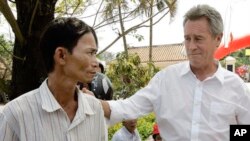American Larry Colburn, who became famous for his actions during the Vietnam War, died earlier this month.
He was 67 years old.
Lisa Colburn, his wife of 31 years, told the Associated Press that Colburn died three months after they learned he had cancer.
“He was a very peaceful man who had a great desire for there to be a peaceful world,” she said.
Lawrence Colburn joined the United States military during the Vietnam War. The U.S. government supported South Vietnam in its battle against North Vietnam and its allies.
Colburn was the last surviving member of an army helicopter crew that halted the killing of hundreds of Vietnamese civilians by American soldiers. The incident took place in the village of My Lai on March 16, 1968. It is now called the My Lai massacre.
The three-man crew had been sent to the village to try to find enemy soldiers. Instead, they found murdered, unarmed civilians and U.S. soldiers who were prepared to kill more villagers.
Hugh Thompson, the pilot, landed the helicopter between villagers who were still alive and troops who were planning to shoot them. Thompson told Colburn and the other crew member, Glenn Andreotta, to prepare to shoot the Americans if they tried to kill the civilians. Colburn and Andreotta agreed.
In 2006, Colburn told the Democracy Now radio program that the helicopter crew saw troops walking toward about 10 villagers who were hiding in a bunker. He said the crew “decided that if we didn’t do something within the next 30 seconds, these people would die. So (Thompson) landed the aircraft in between the advancing American troops” and the villagers.
Thompson spoke to the leader of the soldiers “and asked him how we could get these people out of the bunker. They were obviously civilians. And the lieutenant replied he’d get them out with hand grenades. Mr. Thompson, who was outranked by this lieutenant, actually gave the lieutenant an order, told him to keep his people in place. He had a better idea, and I think he told him, ‘If you fire on these people when I’m getting them out of the bunker, my people will fire on you.’”
An Army investigation later found that the soldiers had begun killing the villagers without warning. Before the helicopter crew was able to stop the killing, 504 civilians -- mostly women, children and old people -- were dead.
Trent Angers wrote a biography about Thompson called “The Forgotten Hero of My Lai: The Hugh Thompson Story.” He said that Colburn “stood up, shoulder to shoulder with Hugh and Glenn, to oppose and stand down against those who were committing crimes against humanity. Without his assistance, Hugh might not have done what he did.”
Many years after the incident, Colburn and Thompson were given the U.S. Army’s Soldier’s Medal. It is the U.S. military’s highest award for bravery not involving conflict with the enemy.
Glenn Andreotta was killed in battle three weeks after the My Lai shootings. Hugh Thompson died in 2006.
In 2008, 40 years after the My Lai massacre, Larry Colburn returned to the village. He met Do Ba, whose life Colburn had saved on that day.
Charles Pierce wrote on Esquire.com that Colburn’s actions are “one of the more astonishing displays of courage of which I’ve ever heard.” He wrote that Colburn’s funeral should “be on national television. Children (should) read about him in school. There (should) be memorials on the National Mall and at West Point.”
I’m Jonathan Evans.
The New York Times and the Associated Press reported this story. Christopher Jones-Cruise adapted the reports for Learning English. George Grow was the editor.
We want to hear from you. Write to us in the Comments Section, or visit our Facebook page.
_______________________________________________________________
Words in This Story
bunker – n. a strong building that is mostly below ground and that is used to keep people, soldiers, weapons, etc., safe from attacks
grenade – n. a small bomb that is designed to be thrown by someone or shot from a rifle
outrank – v. to have a higher rank or position than (someone)
shoulder to shoulder – expression united together to achieve a shared goal
astonishing – adj. causing a feeling of great surprise or wonder
National Mall – n. an area in Washington, DC where there are many monuments and memorials
West Point – n. town in New York where the United States Military Academy is located. The USMA trains young men and women to be military officers.







